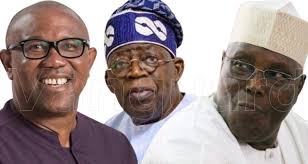Newabreak: Opinion poll shows Tinubu-Shetima win February 25 Presidential election, Atiku, Kwankwanzo, Obi trail behind
By Ahmed Sanusi and Samuel Ogunsona
A new poll released on Thursday has indicated the victory of All Progressives Congress, (APC) Presidential candidate, Asiwaju Ahmed Tinubu and his running mate, Kashim Shetima at the February 25 election. The 49-page public presentation of the poll was made on Thursday in Lagos.
The Nigerian Human Rights Community, (NHRC), a coalition of 80 civil society organisations which conducted the poll in collaboration with Digital Reasoning, a technical communication team said the APC is certain to win the poll given the existing realities.
The polls also confirmed a two-horse race for the second position between Alh. Atiku Abubakar of the Peoples Democratic Party (PDP) and Peter Obi of the Labour Party (LP) while Senator. Rabiu Kwankwaso came a distant fourth as all other contestants together scored an insignificant total.
It is worth noting that Tinubu’s lead in the four of the most populous states with the highest number of voters in Lagos, Kano, Oyo and Bornu may have contributed to his lead. Tinubu’s lead is sizable but not unassailable in Kebbi, Bauchi, Katsina, Plateau and River States because as at January 2023, the largest concentration of Undecided voters reside in these states and there is a rising disaffection with the ruling party in the states. Therefore, these states are battlegrounds yet to be conquered.
Out of the 19365 respondents interviewed, 7940 (41%) are voting for the candidate of the APC while 5035 (26%), 4067 (21%), and 1743 (9%) are voting for the candidates of PDP, LP, and NNPP respectively. 1162 (6%) of the respondents are rooting for the other candidates.
The Nigerian Human Rights Community, NHRC poll revealed that the presidential candidate of the All Progressives Congress (APC) , Bola Ahmed Tinubu holds a magnificent lead and is on course to win the 2023 general elections.
The detailed analysis in this work and the heterogenous nature of respondents, there is an indication that the forthcoming Presidential Elections is between 3 major candidates of the APC, PDP, and LP parties with Bola Ahmed Tinubu of the APC as the most dominant and widely accepted candidate followed by Atiku Abubakar (PDP) and Peter Obi (LP) It is worthy of note however that the gray states (Rivers, Kebbi, Bauchi, Plateau, and Katsina) which house largely undecided voters and indifferent incumbent governors who are too close to call could sway the outcome in favor of the presidential candidate who is able to harness their voting strength.
Making the Presentation in Lagos, the group’s Secretary General, Taiwo Adeleye said the research which spanned six months was concluded in January.
The group said The study employed Random Sampling with emphasis on urban and rural population with focal point on the voting age of 18 and above. The researchers adopted a sample of 19,365 respondents from across the 36 states and the Federal Capital Territory, (FCT) using combination of written and oral questionnaire with oral interviews where necessary. People living with disabilities were also involved as respondents. The NHRC regrets that it could not capture enough respondents in the IDPs in Benue and Bornu States. Our researchers also could not visit 10 local government areas in the South East, North East and North West due to security concerns.
The aim of the Poll is to determine the fears and asirations of voters across party lines towards the 2023 general election. The data collection and analysis focused on registered party members with PVC, which comprises men, women,youths & People living with disabilities.
The group said questionnaires were administered by our trained field interviewers across the country in English, the three major languages namely; Hausa, Igbo, Pigin and Yoruba while indigenous languages were adopted where application and when respondent cannot speak English or any of the three major languages with our experienced field supervisors overseeing and ensuring the integrity of the data collection process. The responses were coded and analyzed to draw meaning using statistical software.

